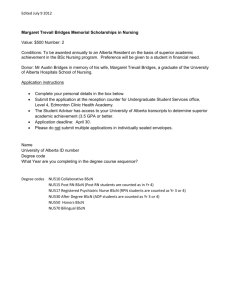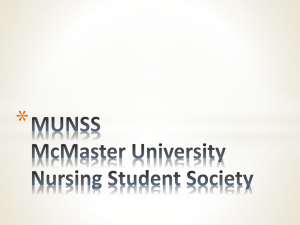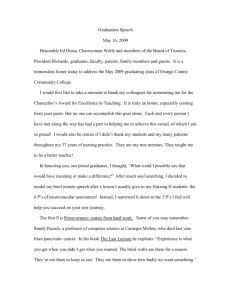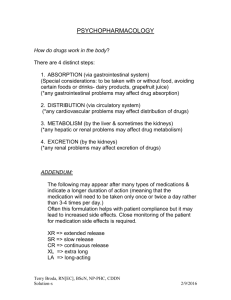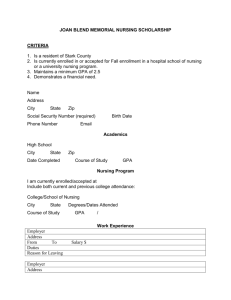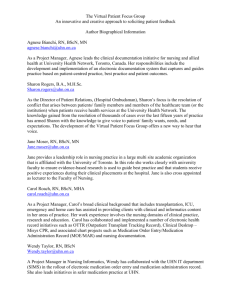THREE PARTNER COLLABORATIVE EVALUATION OF STUDENT
advertisement
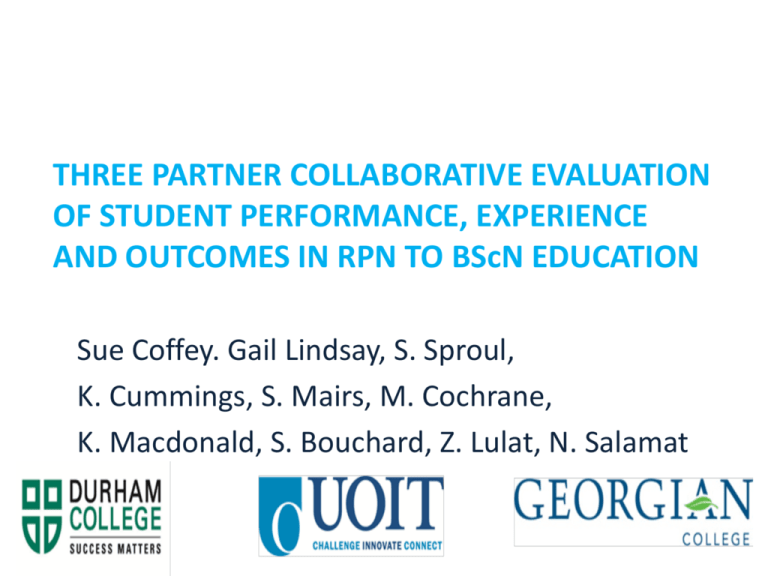
THREE PARTNER COLLABORATIVE EVALUATION OF STUDENT PERFORMANCE, EXPERIENCE AND OUTCOMES IN RPN TO BScN EDUCATION Sue Coffey. Gail Lindsay, S. Sproul, K. Cummings, S. Mairs, M. Cochrane, K. Macdonald, S. Bouchard, Z. Lulat, N. Salamat AGENDA • • • • • • Who are we? What did we do? How did we do it? What did we find? How does it matter? Audience dialogue RPN TO BScN PROGRAMS • Bridging/accelerated nursing programs are the most rapidly growing educational offerings in North America • Currently 6 universities and 10 colleges in Ontario are involved in RPN-BScN bridging education • Virtually no evaluative data is available on these programs WHO ARE WE? • Collaborative BScN Program began in 2003 with UOIT in partnership with Durham College • RPN to BScN Program began in 2005 with 35 students (F2F; one campus); integrates with Collaborative BScN Program and Health Sciences • FT 8 semesters; PT 12 semesters • UOIT/Durham College 7 year CASN accreditation WHO ARE WE? (continued) • Georgian College entered the partnership in 2009 (cohort model, offered on a campus ~ 120km away) • Uniquely integrated with a collaborative bridging term built directly into the program • Total of 432 students in program through 7 intakes • Students admitted from all 23 English-speaking PN programs WHAT DID WE DO? In December 2011, the RPN-BScN program offered in collaboration by UOIT, DC, and GC received funding from the College-University Consortium Council (CUCC) to look at: • Student performance in our bridging program • Student behaviour in our bridging program • Student experience of bridging education • Outcomes of our bridging program for students 3 PHASE STUDY Phase 1 Student performance Student tracking data analysis Student experiences Phase 2 Creating a composite of the context of our students’ lives Facilitators and barriers to success in bridging education Student perceptions Phase 3 Outcomes of bridging education for graduates HOW DID WE DO IT? Multi-method inquiry: • Analysis of institutional data, admission records, GPA, program completion • Focus groups & LimeSurvey questionnaires with students, and • Telephone interviews with employers & graduates PHASE 1 ANALYSIS Data Sources Student tracking information on >400 students from 2005-2012 • Application information • Assessment of transfer credits once admitted • Student performance (course performance including comparison with other nursing and HLSC students, term by term and ongoing cumulative GPA) • Length of time to program completion, attrition rates Focus group interviews with >100 students exploring experiences within the program PHASE 2 ANALYSIS Online data collection with current students in spring of 2012 Quantitative data collection: • Demographic data revealing the context of their lives (work, finances, responsibilities, etc.) • Barriers and facilitators (employment factors, personal factors, academic factors) • Academic supports and services Qualitative Exploration • Student experience of change to self and professional role • Student experience of the program year by year PHASE 3 ANALYSIS • Enhanced statistical analysis of student tracking data from phase 1 to identify predictors of success in the program • Graduate experience and perceptions – outcomes, transition & impact explored in fall 2012 with 30 participants WHAT DID WE FIND? • Description of student experience into, through and after RPN to BScN Program completed • Affirmed academic supports • Identified predictors of success & barriers • Created evidence-base for curriculum development PHASE 1 FINDINGS TRANSFER CREDIT Percent of Students Receiving Additional Transfer Credit by Year and Campus Percent 100 90 80 70 60 50 40 67 30 20 40 39 45 48 50 39 51 46 10 19 34 0 2005 Oshawa 2006 Oshawa 2007 Oshawa 2008 Oshawa 2008 Lindsay 2009 Barrie 2009 Oshawa 2010 Barrie 2010 Oshawa 2011 Barrie 2011 Oshawa COMPARATIVE OVERALL GPA 2006-07 2007-08 2008-09 2009-10 2010-11 2011 TOTAL RPNs TOTAL 2.82 2.97 3.04 3.06 3.00 2.96 2.99 Collaborative Nursing TOTAL 2.77 2.80 2.77 2.90 2.93 2.80 2.86 STUDENT PERFORMANCE Course RPN-BScN Bridging Students Pathophysiology 1 Pathophysiology 2 Statistics Research Ethics Collaborative Nursing Students = Knowing through Inquiry Nursing Leadership WORTH NOTING Since the first graduation of RPN to BScN students in 2008, on 2 out of 4 years, graduates of this program have been awarded the Faculty Medal for highest grade point average throughout the entire Faculty of Health Sciences (composed of 5 programs including nursing) TIME TO COMPLETION Percentage of Students who Complete the RPN to BScN Program in 3 Years 22% 3 year program completion Additional years required for completion 78% PROGRAM COMPLETION STATUS • • • • Completed program: 148 (34%) Withdrew: 85 (20%) Actively studying: 154 (35%) Not enrolled for 2-3 terms: 48 (11%) FOCUS GROUP FINDINGS Data from 110 students (2008-09) • Students enter the program familiar with content encountered but unprepared for university and focus of new learning • Student experience facilitated by support from faculty and peers in the program, academic resources, design of the program and clear expectations • Students experience barriers such as finances, workload, transportation, technology and developing peer supports from outside to inside the program PHASE 2 FINDINGS RPN-BScN students are working full-time, studying full-time, disrupting the stability of their lives, and, at the same time, outperforming their collaborative nursing program and health science student counterparts. HIGHLIGHTS OF PHASE 2 FINDINGS Unique characteristics of our bridging students include: • General demographics • Dependent care responsibilities • Area of nursing practice • Commuting times • Income and school-related debt STUDENT EXPERIENCE OF THE PROGRAM Themes a) The program is intense and demanding. b) Students describe the need to implement strategies for academic success and work-life balance. Life through the duration of the program will be different for students and their families. c) The first 2 years of the program are more often characterized by struggle and frustration with workload, whereas the final year of the program reveals insight into accomplishments. Summary of Comments There are many comments about the heaviness of the workload and the need for time management and organization. Students recognize school must be a priority and that it changes a person’s life in relation to family, work, and the composition of their personal life. Students resist program requirements initially, feeling burdened with the demands they experience in multiple areas of their lives. Students experience a struggle to become self-directed, more independent learners than in their past educational experiences, but see this skill as valuable as they complete the program. FACILITATORS & BARRIERS TO SUCCESS • 5 point Likert scale (strong barrier – strongly supports my success) • Areas of inquiry included: Employment factors Personal factors Academic factors Other factors FACTORS SELF-ASSESSED BY STUDENTS Employment Factors Personal Factors Academic Factors Academic Factors (Part A) (Part B) Other Factors Flexibility Family support Writing centre Private tutor Financial Job security Colleague support Academic advisor Tutorial assistant Health centre Job availability Employer support Program coordinator Writing requirements Counselling centre Work support for CE Technical skills Faculty Math requirements Stable family income LOA Writing skills Computer access/IT support Program of study Access to a vehicle Peer attitude to CE Personality traits Online learning Online format Access to public transit Work-life balance Face-to-face learning Face-to-face format Access to childcare Clinical learning scheduling Recreation Library Outlets for stress release FACILITATORS OF STUDENT SUCCESS • Employment Factors: Work schedule flexibility • Personal Factors: Family support, technical skills, writing skills, personality traits, work-life balance • Academic Factors: Overall program of study, online learning, face to face learning, clinical learning • Other Factors: Access to a car BARRIERS TO STUDENT SUCCESS • Employment Factors: Lack of work schedule flexibility • Personal Factors: Lack of employer and colleague support • Academic Factors: Tutorial assistants, scheduling of classes (day/time) • Other Factors: Financial, lack of stable family income, lack of access to childcare PHASE 2 MESSAGE Transition into/through the RPN-BScN program is characterized by a process of progression from being: reactive/resistant responsive proactive/transformative PHASE 3 FINDINGS “You don’t go into nursing to get a lot of praise for sure, and the hours are tough, but being a nurse is something I always wanted to be and I would recommend to all people thinking of going into nursing to get their degree because it does make such a big difference.” (2010 RPN-BScN Graduate) PHASE 3 DATA • 30 graduates (20% of total graduates to date). • 19 completed online survey; 11 took part in a telephone interview • 77% Oshawa campus; 23% Barrie Campus • 3 years to complete program: 77% • 97% successful on first writing of CRNE GRADUATE PROGRAM OUTCOMES Graduates describe 3 areas of change: • Greater freedom, choice & flexibility within their work life • Greater opportunity to work within their chosen nursing specialization • Growth experienced on both personal and professional levels IMPACT OF BECOMING AN RN Graduates describe 4 impact themes: • Increased self-esteem & confidence • Pride in achieving an important goal • Moderate increase in salary or job security • Heightened self-appraisal of professional freedom & autonomy THEMATIC ANALYSIS 3 levels of abstraction from NVivo 9/10 data RPN to BScN program graduates undertake an external process of role transition as they become employed as RNs, while undergoing an internal process of personal and professional transformation through the experience of RN role enactment. SYNTHESIS ANALYSIS: SCATTERPLOT DATA Further inquiry: • Relationship between entrance GPA and bridge term GPA (+) • Relationship between “years out” and bridge GPA (-) • Amount of additional transfer credit (+) • Relationship between entrance GPA & GPA at graduation (+) • Relationship between admission GPA and program completion (no difference) RPN TO BScN PROGRAM EVALUATION SUMMARY Qualitative analysis of student experience Quantitative analysis of student performance Quantitative analysis of the context of student lives Students’ perceptions & evaluation of facilitators, supports and services as well as barriers to RPN to BScN education • Comparison of RPN to BScN students with traditional nursing/university students • Qualitative analysis of graduates perceptions of transition • • • • QUESTIONS TO INVOKE DISCUSSION • What is your organization doing to support RPNBScN students to reach success? • What assumptions do you/your organization have about bridging education for RPNs into BScN Programs and the RN role? • What would be helpful to know more about from your/your organization's perspective about program evaluation research into RPN to BScN Programs?
